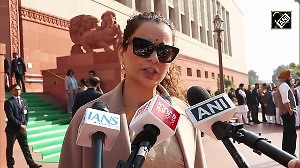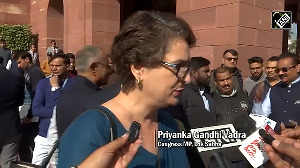Ask any political pundit in India about what he or she thinks about the likely outcome of 2009 election and the reply is more or less similar; that 'it will be a hung Parliament' and that the 'picture is quite confusing'.
But, that may not be entirely true. Here are few things that are not confusing.
Under no circumstances will Left parties support any government led by the Bharatiya Janata Party. If at all the BJP gets more seats than Congress, it will still have less chance of grabbing parties attached to the Third Front.
National Democratic Alliance rule notwithstanding, BJP is still facing 'untouchablity' on the issue of communalism. While Janata Dal-United chief Nitish Kumar reminds them privately, Biju Janata Dal chief Naveen Patnaik did so publicly.
Atal Behari Vajpayee reduced the intensity of the opposition to BJP, but it still persists as the party has been unable to bring Muslims on board. The process of inclusive politics has been non-starter ever since the controversy over LK Advani's remarks on Pakistan's founder Mohammad Ali Jinnah.
So, 'secular' credentials of a political party and a leader makes them stronger in coalition politics. The identity of BJP as a mere Hindu party is a huge minus point in the era of coalition politics where regional parties with sensitivity to minority votes call the shots.
Even BJP admits that the Congress-led block's image is of a group comprising secular parties while NDA comprises non-Congress forces and Third front of non-Congress and non-BJP parties. This is an imprint that is hard to wash off like Amitabh Bachchan's public image after Zanjeer and Deewar.
BJP is the biggest loser of this branding of political blocks and that is why its chances are looking weaker than other two blocks. Regional parties like Mayawati's Bahujan Samaj Party, Telugu Desam Party, Trinamool Congress and Samajwadi Party are unlikely to change their stance over Muslim votes in their region in coming decade. So, in any election bargain BJP will have to shell-out more favours for its alliances than Congress to get them on board.
Second, there is no confusion over the fact that whatever happens there is no way Congress and BJP will ever come together to form any kind of government. Not because their identity will be destroyed if they shake hands but because there is no chemistry between their top leadership to even share a cup of tea.
In this generation it is unlikely that these two parties will do anything jointly in the name of 'national interest'. That's why the idea of the Third Front will always remain attractive for regional players and it is the necessity of small players to unite to get a good bargain from BJP or Congress when the election results are announced and before government formation.
Congress leader Manish Tiwari may ridicule the Third Front but in the business of politics these seasonal Third Fronts are like FICCI/CII of regional players to get the best bargains for themselves.
The current situation is very well described by a BJP leader who calls some regional leaders as having 'ideology-less flexibility'. Powerful leaders like Mayawati, Naveen Patnaik and Jayalalithaa (All India Anna Dravida Munnetra Kazhagam) have been 'neutral' in their ideological stance and have acquired 'independent' position in the political set up. They don't take hard position on any issues related to Congress or BJP so as to retain the bargaining chips during government formation.
It is quite clear that these days regional leaders are not talking of 'revenge' and 'vengeance' -- that language is just absent. These days regional leaders don't abuse BJP or Congress too much and too frequently.
BJP calls the Naveen Patnaik episode 'not an accident but coincidence of history'. Leaders like Patnaik have entered politics without ideology and can jell with any political formulations. Twenty years back these 'unattached flexible' leaders would have been dubbed as opportunistic and devious but today they are posing as prime ministerial candidates.
In this scenario, BJP is struggling to find ways to keep up the momentum. Jaitley had on March 13 delightfully told media how the BJP has a trump card in its pocket. He explained that BJP has divided states into four categories:
- 'A' category states are those where BJP is directly challenging Congress. These states include Madhya Pradesh, Gujarat, Rajasthan and Delhi. The BJP wants to put maximum force here to gain votes.
- 'B' category states are those where the party is sharing political space with non-Congress parties. In Andhra Pradesh it is in the opposition with Telegu Desam Party or in Orissa where it was with a non-Congress force like BJD till recently. Here BJP will try to focus on hitting Congress prospects hard.
Jaitley says that the party's strategy is to get enough seats in assembly elections of AP and Orissa to make sure that a non-Congress government can't be made without its support. This will, BJP thinks, force TDP or BJD to come back to NDA fold to help BJP-led NDA form government in New Delhi. - BJP's C category states include Tamil Nadu, West Bengal and Uttar Pradesh where two staunch opponents are playing games. If BJP performs well in first two categories, parties like Dravida Munnetra Kazhagam, BSP and Trinamool Congress will play their cards accordingly post election.
- The D category states include Kerala and some smaller states where BJP has no stake.
The irony is that in A and B states if Congress loses more seats, BJP will have to deal more with Third Front constituents or floating leaders.
Nationalist Congress Party chief Sharad Pawar, who has not joined the Third Front, said on March 12 that 'the UPA cannot ignore the Third Front. The two will have to come together after the elections'. The same day his party's general secretary, D P Tripathi, told rediff.com, "Let me tell you, without Left parties' co-operation no new government will be formed."
When asked about how Pawar would make his bid for the prime minister's post with maximum a dozen or so seats in Lok Sabha, he said, "Why dozen? Just wait and see. Left parties will get less seats this time, but still they will have some 35/40 seats and that is enough in Indian politics."
Some forty years ago, legendary J R D Tata had seen the work of Sharad Pawar in the Baramati region as a youth leader. Tata was so impressed by him that he said one day, Pawar will become prime minister. Today, Pawar says that a Maharashtrian should become PM.
A couple of days back, Communist Party of India leader A B Bardhan had hinted that Pawar can also get support to be prime minister. Samajwadi Party general secretary Amar Singh has repeated many times that his party will not oppose Pawar's candidature.
Shiv Sena and Pawar's not-so-clandestine relations are known. Since almost a decade, innumerable articles have been printed on Pawar with title 'man who wants to be PM'. Pawar's activity has disturbed Congress so much that the latest confrontation of Home Minister P Chidambaram against the Indian Premier League is dubbed by many as Congress's anti-Pawar attack.
Politicians with ambitions, money power and caste equations on their side are quite clear about the ways of fulfilling their ambitions. They are awaiting the election results to begin their operation to grab power by all means.
Ideology is the least obstacle in the game. As they say, now BJP and Left parties are the only two parties who proclaim some ideology.
Arun Jaitley says, "But, Left parties have diluted their strategy, if not their ideology, of not talking about caste or not supporting caste-based parties."
Any doubt this election will produce five Amar Singhs in Indian politics? Let there be no confusion about it.





